

Stuttering. Stuttering (/ˈstʌtərɪŋ/; alalia syllabaris), also known as stammering (/ˈstæmərɪŋ/; alalia literalis or anarthria literalis), is a speech disorder in which the flow of speech is disrupted by involuntary repetitions and prolongations of sounds, syllables, words or phrases as well as involuntary silent pauses or blocks in which the person who stutters is unable to produce sounds.[1] The term stuttering is most commonly associated with involuntary sound repetition, but it also encompasses the abnormal hesitation or pausing before speech, referred to by people who stutter as blocks, and the prolongation of certain sounds, usually vowels semivowels.
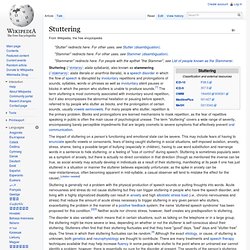
For many people who stutter, repetition is the primary problem. Blocks and prolongations are learned mechanisms to mask repetition, as the fear of repetitive speaking in public is often the main cause of psychological unease. The impact of stuttering on a person's functioning and emotional state can be severe. Characteristics[edit] Causes[edit] Coarticulation. Coarticulation in its general sense refers to a situation in which a conceptually isolated speech sound is influenced by, and becomes more like, a preceding or following speech sound.
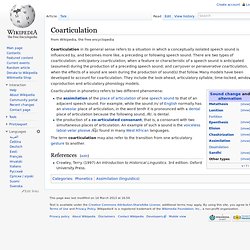
There are two types of coarticulation: anticipatory coarticulation, when a feature or characteristic of a speech sound is anticipated (assumed) during the production of a preceding speech sound; and carryover or perseverative coarticulation, when the effects of a sound are seen during the production of sound(s) that follow. Many models have been developed to account for coarticulation. They include the look-ahead, articulatory syllable, time-locked, window, coproduction and articulatory phonology models. Coarticulation in phonetics refers to two different phenomena: The term coarticulation may also refer to the transition from one articulatory gesture to another. Crowley, Terry. (1997) An Introduction to Historical Linguistics. 3rd edition. Assimilation (linguistics) In linguistics, assimilation is a common phonological process by which one sound becomes more like a nearby sound.
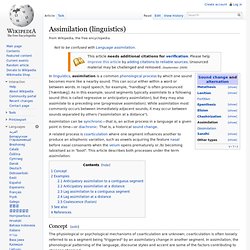
This can occur either within a word or between words. In rapid speech, for example, "handbag" is often pronounced [ˈhæmbæɡ]. As in this example, sound segments typically assimilate to a following sound (this is called regressive or anticipatory assimilation), but they may also assimilate to a preceding one (progressive assimilation). While assimilation most commonly occurs between immediately adjacent sounds, it may occur between sounds separated by others ("assimilation at a distance").
Assimilation can be synchronic—that is, an active process in a language at a given point in time—or diachronic: That is, a historical sound change. The physiological or psychological mechanisms of coarticulation are unknown; coarticulation is often loosely referred to as a segment being "triggered" by an assimilatory change in another segment. PGmc *nistaz > OE nest. Co-articulated consonant. Co-articulated consonants or complex consonants are consonants produced with two simultaneous places of articulation.
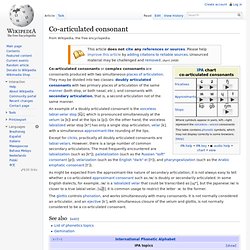
They may be divided into two classes: doubly articulated consonants with two primary places of articulation of the same manner (both stop, or both nasal, etc.), and consonants with secondary articulation, that is, a second articulation not of the same manner. An example of a doubly articulated consonant is the voiceless labial-velar stop [k͡p], which is pronounced simultaneously at the velum (a [k]) and at the lips (a [p]). On the other hand, the voiceless labialized velar stop [kʷ] has only a single stop articulation, velar [k], with a simultaneous approximant-like rounding of the lips. Except for clicks, practically all doubly articulated consonants are labial-velars. However, there is a large number of common secondary articulations. The glottis controls phonation, and works simultaneously with many consonants. Cluttering. Cluttering (also called tachyphemia) is a speech and communication disorder characterized by a rapid rate making speech difficult to understand, erratic rhythm, poor syntax or grammar, and words or groups of words unrelated to the sentence.
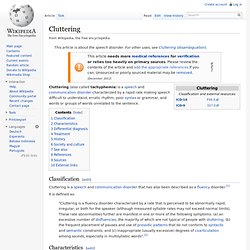
Classification[edit] Cluttering is a speech and communication disorder that has also been described as a fluency disorder.[1] It is defined as: "Cluttering is a fluency disorder characterized by a rate that is perceived to be abnormally rapid, irregular, or both for the speaker (although measured syllable rates may not exceed normal limits). Characteristics[edit] Spoonerisms, malapropisms, Colemanballs, and Freudian slips are examples of cluttering. Cluttering is sometimes confused with stuttering. Stutterers are usually dysfluent on initial sounds, when beginning to speak, and become more fluent towards the ends of utterances. Stuttering is characterized by struggle behavior, such as overtense speech production muscles. Differential diagnosis[edit]